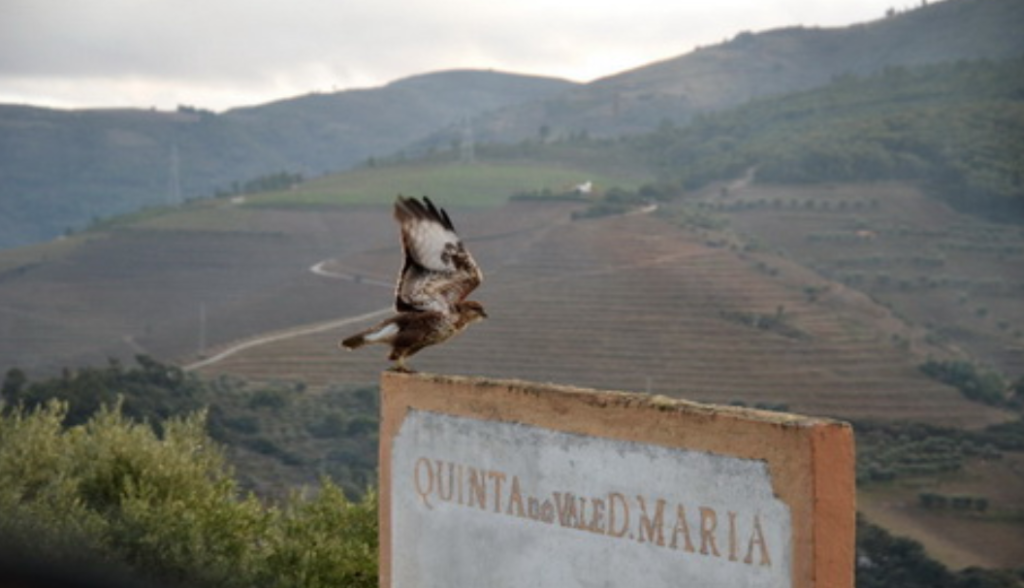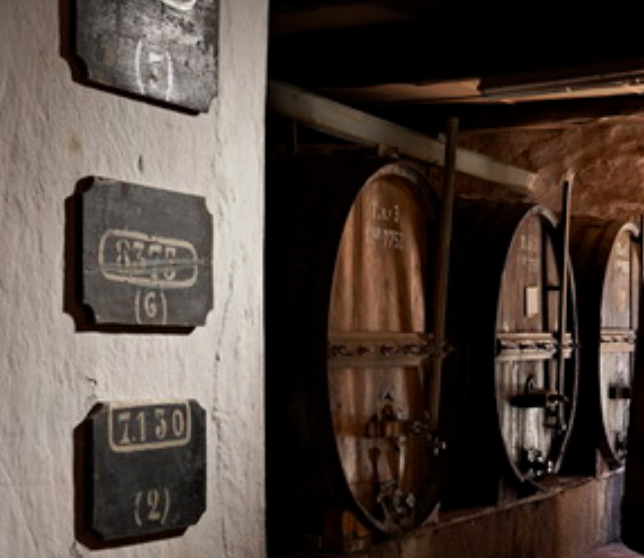The Douro is a wine region that has both remained loyal to its history but also seen great changes in recent years. On my visit, I sat down for a chat with Francisca Van Zeller, the youngest generation of the Van Zeller family which established themselves as an important Port shipper family in the late 1700s with a fleet that extended to over 20 boats. The family has owned and worked with many of the great estates in the Douro, including Quinta de Roriz and Quinta do Noval, and today the family focuses on producing high quality (unfortified) wine under their Vale D. Maria brand.
In this interview Francisca describe’s the history of the Douro and what vineyard and viticultural practices have changed, and which ones they are bringing back to the future:
Van Zeller wine tasting notes (Vale D. Maria)
Vinha de Martim White 2017 (Vale D. Maria)
This white blend has real weight to the palate, while maintaining bright citrus aromatics and a zesty acidity. This is a bigger food wine which would sit nicely along many different – bigger – dishes on the table.
CV White 2017 (Vale D. Maria)
Old vines at high altitude and a diverse blend of grapes make this wine complex and engaging. It is full bodied with a richness and creamy texture while the fruit and floral expressions keep it youthful and bright. Delicious wine.
VZ Douro White 2017 (Van Zellers)
A bright and aromatic blend with some length and weight to the palate. This is a great introduction to Douro white blends, with a less eye-watering price point.
Rufo 2016 (Vale D. Maria)
Excellent value for a Douro red and a great introduction with bright red fruits and an aromatic and appetising finish. A simple style, but done well.
VVV Valleys 2016 (Vale D. Maria)
From three valleys – Pinhão, Douro and Torto – this terroir blend offers a textural red with plenty of fruit and mineral character, giving you good value for money and a distinctly Douro expression.
Vinha do Rio 2016 (Vale D. Maria)
Violet notes invade the glass, before dancing off to reveal wild herb, red fruit and a mineral note. Feminine and exceptionally elegant, this is a real show pony of the Douro. Concentrated and long, but not at all overbearing. One of my favourite wines tasted in the Douro.
CV 2016 (Vale D. Maria)
An inky wine with dark fruit notes, an appealing graphite note and savoury flavours. This is mouthwatering while being dark and brooding. The power of the Douro, masterfully controlled into a harmonious and memorable blend.
The Douro past, present and future: Francisca Van Zeller interview transcript

Francisca, you are part of the Van Zeller family, which was an important Port shipper in 1780 when it was founded. Can you tell us a bit about the difference in the structure of the wine business back then to how it is today?
Back then most of the families that came to work the Douro valley, known obviously as Port wine from the 1600s onwards, were shippers. So they were traders or merchants, they weren’t necessarily grape growers or wine producers. They knew the business side of things, and they had the route to market. My family at the time I think owned around 20 different ships, so they controlled much more of the logistics side and wine was obviously exported in the actual barrels. With the brandy that was added to preserve the wine through the travelling that it had to do to get to the consumer in either England or Eastern Europe or Brazil to the different export markets. So they were basically located more on this side, where we are – in Porto and [Vila Nova de] Gaia and did the exportations. My family was actually the first to go into the region, and run an estate – which was Quinta de Roriz – they did that earlier in the mid-1700s and this idea of actually getting control of the vineyard was new at the time. So we were mainly dependent on the local farmers, the wine used to be shipped down to Gaia, aged in Gaia and then either blended or shipped out. And then there’s a movement going into the region and starting to take control of viticulture itself, and the first Port wine and vintage Port to be bottled with an estate name was by my family at Quinta de Roriz. Obviously the progression of the wine trade involves the blending, the bottling, so much greater know-how of producing and creating wines, and creating wines that go towards what the consumer demanded. So the blends what we now know as the 20, 30, 40 year old blends, they weren’t categories at the time. There used to be large books for each agent or each client, and that would be the blend. That was the biggest secret in the Port house – it was Berry Brothers or other special agents throughout the world would want a special characteristic in their wine and we would know more or less how to blend the wines to deliver what they would like. Obviously nowadays we have categories, we have to fit to these different styles that have been more or less pre-defined. Each Port house has their own style within the different categories, then the LBVs and the Vintage Ports, but all these different categories are much later. They are 20th century categories and definitions.
Excellent, and there’s another category in which your family has been quite pioneering and helped push, which is the production of wine in the Douro rather than fortified Port. What was the potential that your father saw for this? And why do you believe that the Douro can be a world-class wine producer as well as Port?
For the diversity. So, looking at the vineyard itself and the different grape varieties that we have – the diversity is so immense, depending on what we have in the vineyard, planted in the vineyard or how we then transform it. We can create two different products. We have a lot of heat obviously during the end of the maturation period. And then the summer. But during the rest of the year it is actually a very cool region. And because it is schist stone and the way the soil works, our vineyards find water quite easily because they can grow their roots quite deep. So we tend to be able to control water levels more or less, and not have extreme heat in many years. We actually had excess water in the last few years. So I think it is the diversity that allows us to create two different products. And obviously technology if you’d like, and temperature control, have allowed us to have wines that ferment fully under the ideal conditions. Even though us as producers at Quinta Vale d. Maria we still respect the old ways, the lagar fermentations, so we still use the old vineyards and the old plantings. Simply we started picking them slightly earlier, and then we allow fermentations to finish without adding the brandy.
Excellent. And another way in which you’ve been respecting the past traditions is in planting your new vineyards. You’ve actually gone back to random planting as they would historically. Can you explain a bit about the changes in vineyard training in the Douro? And why you’ve decided to go back to this random field blend?
There’s the post-phylloxera patamares, or the terraces which have a large sun exposure, they are quite balanced. And you have a wall and then another steep valley. And then in the early 70s and 80s what we started doing in the Douro was the much closer patamares terraces, which look like steps. That difference makes the vineyard have less density, fewer plants per hectare. And my father still wants to preserve the sloped vineyards, with higher densities per hectare to promote plant competition, concentration, get a more hetrogenous maturity timing with all the different varieties. What we are looking for is diversity all the time. Bringing in as many varieties as possible, to bring in the characteristics of the Douro and make each parcel unique, each vineyard unique and respecting what we originally had at the estate. The way to do that is to plant them as closely together as possible, so that they compete and they balance each other out quite naturally. And we can pick them all together to be able to ferment them together. And this is, at the end of the day, the final product that we have to offer, that we want to offer – and how do we have to treat the vineyard for that. So we went back to high density, high diversity in this new vineyard which we planted we have 16 different grape varieties – I don’t know the majority. We selected 16 for less than a hectare, so there is no main variety. We are not trying to make a characteristic, we are exactly trying to express diversity.
Excellent, and if you were to describe a Douro red in the glass, with all this diversity, and the unity of these different varieties. How would you describe it to someone who is trying their first glass of Douro red wine?
One of the things about the Douro, and I think you’ll see it today in the new Douro, different producers can give a different angle to what they are producing. Quinta d. Vale Maria to me are a great expression of comfort. It is a wine that envelops you in a different experience without them being heavy. I think that’s the challenge in the Douro, is trying to get harmony within a blend and within a wine. And both freshness with a lot of expression, so an explosion of different fruits, of different flowers. You can really feel the Douro, so you have to go to the Douro to really understand the smell of the schist, the minerality you get behind some of the wines. And all the different biodiversity. For me, it is comfort. For me that’s a pleasurable feeling. I think other producers in the Douro produce different styles – fresher styles, heavier styles, fruitier styles, oakier styles, you get a lot of different things. That for me is the big interest of the Douro. It’s a permanent discovery.
And all the more reason to visit!
Exactly!

